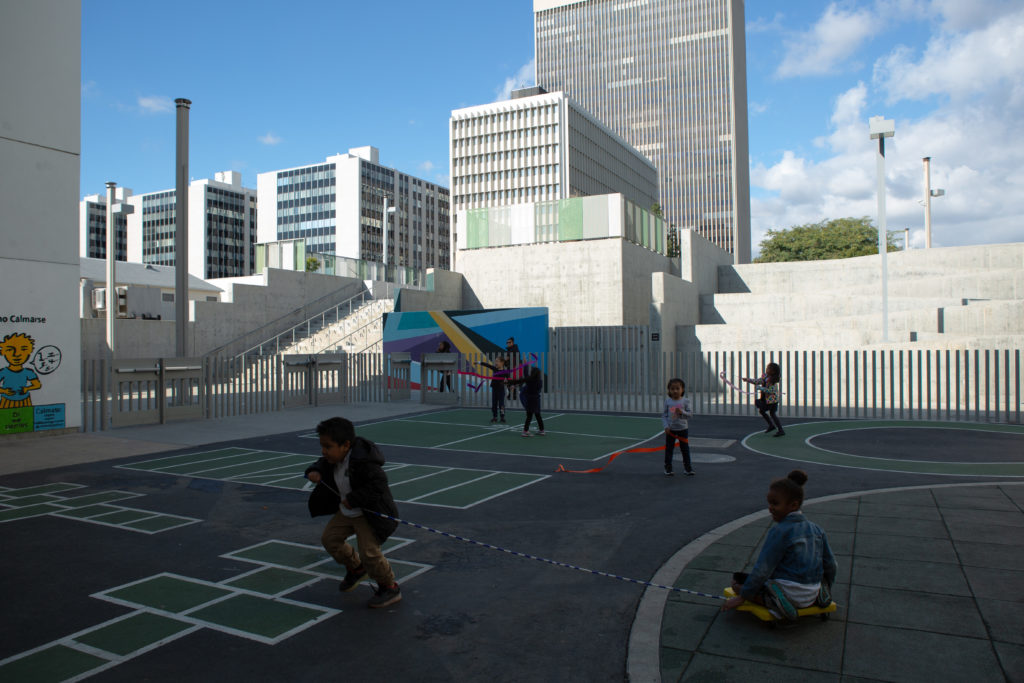


Photo by Allison Shelley for EDUimages
As schools prepare to welcome students back into buildings, school infrastructure and facilities are being examined for their ability to meet the health standards being set in relation to the COVID-19 pandemic. Unfortunately, this is not the first time that the state of school infrastructure has been a concern. After highways, K-12 public schools is the largest infrastructure sector in the United States, but there has been systematic underinvestment for years.
In a National Center for Education Statistics (NCES) report, it was found that on average it has been 44 years since the main instructional buildings were constructed and on average 12 years since buildings had major renovations. Dating back to 1995, the Government Accountability Office reported that 28 million students attended uncomfortable, unhealthy, and unsafe schools, and that an estimated $112 billion was needed to modernize and repair school facilities across the country. This situation has only grown worse with the American Society of Civil Engineers providing a “D+” grade for public school facilities in 2021 and there needing to be $145 billion invested each year, to maintain, operate, and renew school facilities.
Each year investment in school infrastructure falls short by $46 billion at a historic spending value of $99 billion per year on maintenance and operations, capital construction, and new facilities spending. School infrastructure funding allocation has mainly been provided by local districts as states approach public education facility funding differently and the federal government provides very little support.
Every weekday, nearly 56 million students and adults are inside over 100,000 public school buildings. Only 20 percent of permanent buildings are in excellent condition. Reports have been shown the impact of school infrastructure on learning. The physical environment of a classroom has the ability to better the student learning experience and increase achievement as it can empower and motivate students to allow for increased concentration. Positive educational outcomes have been found to be correlated with four facility factors :facility age, facility condition, thermal environment, and lighting. A study conducted in Washington, D.C. found that improving school facilities could be a more cost-effective strategy compared to salary increases to improve teacher retention.
Historically, wealthier zip codes have received three times more investment in school infrastructure than low-income zip codes. Low-income communities have historically not been granted the resources to provide the necessary updates to poor roofing, plumbing, and air quality that have existed in both urban and rural schools. The 2016 Federal Bureau of Indian Education Report found that 96 of the 183 federally funded schools were in either poor or fair condition and that facilities had deficiencies that raised health and safety concerns. These facilities “send a message to kids that we don’t value their education, we don’t value them,” stated Lawyers for Civil Rights attorney, Janelle Dempsey, who has found that socioeconomic status aligns with school facility quality. As local school districts cover most of their capital facilities budget, poorer communities historically have received less funding for these projects due to factors such as property values. Funding that is received from states has been ruled by 17 out of 45 state courts to not account for facility inequalities in their school facility funding.
As federal funding provides allocations for K-12 reopening efforts, schools have begun to examine with urgency the maintenance and improvement needs of their school facilities to ensure student and staff safety. Many of the basic safety requirements needed around air quality, connectivity, and personal hygiene are not currently to standard. As schools rethink their school infrastructure in order to open in alignment with public health recommendations, more comprehensive actions can be undertaken to make up for longer term inaction and ongoing need to dramatically improve school infrastructure in this country.
Every state takes a different approach to allocating the funding of school infrastructure. The revenue source for the funds varies widely, and can include state bonds, dedicated lottery proceeds, and dedicated sales tax revenue. The allocation approaches can be grouped into four broad categories being taken by states. Despite state actions, most of the burden to finance capital projects falls on districts, as almost half of states pay less than 10 percent of construction costs. Some states provide no funding for capital spending. In 2015 12 states fell into this category.
Ballot Initiatives: Ballot initiatives are used to pass bond measures by districts to support the direct raising of funds for capital projects. Many times these measures fail due to residents not wanting to raise taxes.
Direct Fund Allocation: Direct allocation and involvement with funding of school capital projects is the least likely funding strategy used by states. While few states provide funds directly as a result of legislation or their funding strategy, another strategy employed under this allocation method is direct payments to vendors and contractors.
Debt Reimbursement and Assistance: Many school districts have taken on massive debt to fund construction projects. As of 2016, school districts have $434 billion in long-term debt. States are taking actions to help ease the debt burdens being taken on by districts.
Grants: Grants are a common way that states allocate funds for school capital projects. Grants are distributed competitively, on a matching basis, annually, or on a non-matching basis. The Reopen and Rebuild America’s Schools Act of 2021 which has been introduced in Congress would provide grants on an equitable basis to improve school facilities.
Implement Best Practice Design Principles | When creating ideal learning environments there have been principles identified by architectural firms who have built and renovated schools across the United States: technology integration, safety and security, transparency, multipurpose space, and outdoor learning. Schools where these principles were implemented found reduced stress, improved creativity, increased collaboration, and independence in students. These principles, with a focus on green school concepts, provide better environments for both teachers and students that “improve health, wellness, and academic performance”.
Use of ESSER Funds for Facilities | The CDC has made recommendations related to COVID-19 around heating, ventilation, and air quality, which has also been identified by the U.S. Government Accountability Office as the major category for updates and replacements needed by school districts. The Elementary and Secondary School Emergency Relief Fund (ESSER) can be used to upgrade HVAC systems, improve indoor air quality, and promote climate literacy within the qualified spending. These health and environment-related updates can promote student achievement as identified in recent studies.
Explore Other Capital Funding Approaches | States and districts can explore other approaches to financing school infrastructure projects. These methods include public-private partnerships, infrastructure banks, and gas and user fees. School boards can also approve surplus capital reserve transfers and use alternative funding mechanisms like an Energy Saving Improvement Program (ESIP) to fund specific projects. Public-private partnerships have been utilized in the past for charter school construction. Prince George’s County in Maryland passed legislation in 2019 to create a Public-Private Partnership Fund to support public school construction.
Conduct Design Reviews and Needs Assessments | States and school districts conduct design reviews to assess school facilities, determine space needs, and prioritize projects on a recurring schedule. Educational Facilities Needs Assessments assess schools based on enrollment, capacity, and square feet per student to determine where prioritization of projects should occur. Space needs in school facilities include gross square footage, bathroom and common areas, non-academic space, playgrounds, and parking. Districts bring in outside agencies to conduct these assessments and development plans. Garrett County in Maryland did this in 2013 and Capistrano Unified School District in California did this in 2017.
Invest in Reporting Technology | Facility improvements need investment in insight gathering to be able to constantly adapt to challenges. Districts and states should make investments in monitoring and training associated with school facility improvements to maintain updates. The Facility Needs Survey program in North Carolina provides a uniform reporting system that helps automate processes associated with understanding schools facility needs. Colorado’s Division of Capital Construction created the Facility Insight Program which includes a portal that provides facility data from statewide assessments.
Use an Equity-Focused Approach | When modernizing school facilities, education equity must be prioritized. Diversity and segregation in schools should be accounted for when making school construction decisions by implementing diversity policies and impact analysis. Fund gaps that exist between high- and low- income schools must be addressed as low-income schools are able to take advantage of more resources to fill the gap in state funding. Connecticut provides reimbursements to magnet schools with school construction projects focused on increasing diversity. States should make sure that any formulas used to distribute funding have an equity approach.
Integrate Energy Efficiency and Sustainability | Schools, districts, and states should integrate energy efficiency in school construction projects where able. The U.S. Government Accountability Office found 41 percent of K-12 public schools had unsatisfactory energy efficiency. Schools can become Green Ribbon Schools in recognition of sustainability practices and resources. In Oregon, Energy Trust of Oregon provided millions in funding for energy efficiency projects in schools which has allowed districts to make upgrades through infrastructure projects during school closings.
Address the Needs of Smaller Schools | It is important for investments to be made in smaller schools as size is related to student achievement in some cases. Additionally, small school districts could be assisted in facility-related projects through cooperatives, which California has considered in the past. Funding formulas should also be adjusted for unfairness that occurs between large and small school districts. Alternatively, smaller districts are more likely to see the benefits of consolidation, as administrative costs would not grow to the degree that they would if two larger districts merged. In South Carolina, $50 million were provided to support districts in consolidation and included funding new and upgraded for facilities